
| Logout |
The State of the Program, Part 4: Special Teams
by Will Stewart, TechSideline.com, 1/15/04
I have this nagging feeling that in the last few years, Virginia Tech special teams aren't what they used to be. So I decided to sit down, do a little analysis, recall the past, and crunch some stats to see if that nagging feeling was correct. What I found wasn't quite what I expected, but it was interesting and illuminating nonetheless.
The Reputation
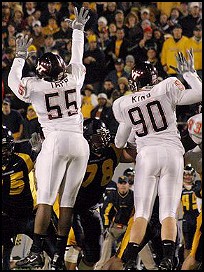 Virginia
Tech has a phenomenal record of blocking kicks under Frank Beamer. The Hokies have blocked 101 kicks in Frank Beamer's
201 games as the Hokies' coach, and in the 1990's, the Hokies blocked more kicks than any other team in the nation.
Virginia
Tech has a phenomenal record of blocking kicks under Frank Beamer. The Hokies have blocked 101 kicks in Frank Beamer's
201 games as the Hokies' coach, and in the 1990's, the Hokies blocked more kicks than any other team in the nation.
In addition to great kick-blocking abilities, the Hokies pride themselves on not giving up returns for touchdowns, having solid punters, and having good field goal kickers. But it's really the kick blocks that make VT stand out.
That's the great reputation VT has for special teams, and it was one that was built over time. But is it still true? Let's take a subjective look, then an objective look.
The Past and the Present
I have a gut feeling that through the 2000 season, special teams were a real force for Virginia Tech, but in the last three seasons, the Hokies have showed some kinks in the armor and have actually lost games because of what's supposed to be their bread and butter.
To analyze this, let's divide the Beamer Bowl era up into to blocks: 1993-1997 and 1998 to the present. The reason? Prior to 1998, the Hokies weren't really known nationally for their special teams expertise, but beginning with a 12-blocked-kick season in 1998, that reputation quickly built. So I'm dividing this analysis up into pre-reputation and post-reputation eras.
As I noted, from 1993 to 1997, the Hokies weren't known for blocking kicks, though they were good at it. They averaged 6.2 blocked kicks per year, with a low of four (1994: 2 punts, 2 FGs) and a high of eight (1995: 4 punts, 3 PATs, 1 FG).
During that time period, the Hokies won a few and lost a few because of special teams. Here are a few that I recall:
1993: Tech lost to WVU 14-13, when Ryan Williams missed a 44-yard field goal with 1:10 to go. Later that year, they beat Rutgers 49-42, a score that included a blocked punt return for a TD by William Ferrell. In the Independence Bowl, an Antonio Banks blocked field goal return for a TD on the last play of the first half sparked the Hokies to a win.
1994: Special teams didn't affect the outcome of any games positively or negatively.
1995: In a 26-16 win over Pitt, Atle Larsen kicked four field goals, and Angelo Harrison blocked two punts. In the Sugar Bowl, Bryan Still returned a punt 60 yards for a TD to bring the Hokies back from a 10-0 deficit.
1996: Special teams didn't affect the outcome of any games positively or negatively.
1997: Miami of Ohio, in a shocking 24-17 win at Lane Stadium, blocked two Tech punts, returning one for a TD, and scored another special teams TD when they faked a field goal and ran it in 32 yards for the score.
From 1993-1997, it was a win some/lose some proposition for the Hokies.
Where the special teams reputation really started to kick in was 1998-2000. In 1998, the Hokies blocked an incredible 12 kicks, returning three for touchdowns, and while they took a bit of a break in 1999 (blocking just 2 kicks and returning a punt for a TD), they were very strong again in 2000, when they blocked 8 kicks, returning 1 for a touchdown, and also had three punt returns for touchdowns, by Andre Davis.
In those three years, the Hokies absolutely dominated some teams with their special teams performance, and nary a chink in the armor appeared. The lone exception, sadly, was the 1999 national championship game, when Florida State blocked a punt for a TD and returned another punt for a TD in their 46-29 win.
Since the start of the 2001 season, however, special teams have been problematic for the Hokies. They're still blocking kicks and running punts back for touchdowns. They even got a kickoff return for a TD from Mike Imoh this season, their first since 1992. But punting is down and inconsistent, placekicking is shaky, opponents' kick return yardage is up, and Tech has out-and-out lost several games since the 2000 season because of poor special teams play.
Special Teams Breakdowns, 2001-2003
Here are the games, in the last three years, where VT has performed poorly on special teams or has lost because of special teams.
2001: In a 22-14 win at Lane Stadium, Jamel Riddle returned a punt 51 yards for a TD, and Tech punter Vinnie Burns dropped a snap deep in Tech territory that Syracuse turned into a 26-yard field goal with 4 seconds left to go in the first half. In the Gator Bowl, a 31-17 loss to FSU, the Noles blocked a second-quarter Tech punt, setting up a 1-yard run by QB Chris Rix.
2002: In a 28-23 win at Boston College, the Hokies gave up 279 yards in kick returns, including an 83-yard punt return for a touchdown by Jamal Burke. BC had 4 punt returns for 105 yards and 174 yards on 5 kickoff returns. Later, in a 50-42 triple overtime loss at Syracuse, Tech placekicker Carter Warley missed two field goals that would have won the game at the end of regulation (46 yards) and in the first overtime (36 yards).
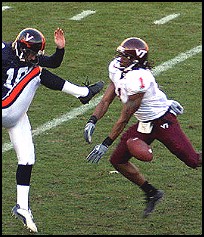 2003:
In a 34-27 loss to BC, Tech again gave up big kick return yardage, surrendering 152 yards on five kickoff returns by BC.
In a 35-21 loss to Virginia, Tech blocked a punt with the score tied 14-14 and returned it for a score, but they were
offsides on the play, giving the ball back to UVa (the Hoos later scored a go-ahead TD). With the score 28-21, the
Cavaliers completely fooled the Hokies with a fake field goal and went on to score the clinching touchdown. In Tech's
52-49 bowl-game loss to Cal, Warley missed three field goals, and he and Brandon Pace kicked three kickoffs out of
bounds.
2003:
In a 34-27 loss to BC, Tech again gave up big kick return yardage, surrendering 152 yards on five kickoff returns by BC.
In a 35-21 loss to Virginia, Tech blocked a punt with the score tied 14-14 and returned it for a score, but they were
offsides on the play, giving the ball back to UVa (the Hoos later scored a go-ahead TD). With the score 28-21, the
Cavaliers completely fooled the Hokies with a fake field goal and went on to score the clinching touchdown. In Tech's
52-49 bowl-game loss to Cal, Warley missed three field goals, and he and Brandon Pace kicked three kickoffs out of
bounds.
The Hokies also had some good moments in that three-year span. In addition to battering some creampuffs with their special teams, VT had a key punt block in the 2001 Miami game that almost sent the game into overtime (everybody remembers that one!). In 2002, the Hokies blocked two LSU punts to help them to a 26-8 victory. Also in 2002, Tech blocked one early Pittsburgh punt and scared the Panthers into a high snap on another, putting Pitt in a big first-half hole. In the 2002 UVa game, the Hokies had a punt block against UVa that was brilliantly choreographed (click here for TSL's breakdown of the punt block) and helped the Hokies to a 21-9 victory.
But there's no denying that the Tech special teams, which were bullet proof from 1998-2000 (to the best of my recollection, and the stats support it), have sprung a leak and have played key roles in important losses in the last three seasons.
For the remainder of the article, I'm going to do some heavy-duty stats analysis (stick with me!) and then draw some conclusions at the end. For the most part, the stats will cover the last 6-8 years, which is basically the time period that VT built their reputation and then recently saw their special teams begin to struggle.
Kick Blocks and Punt Returns
In the last few years, the Hokies have continued to enjoy a great and deserved reputation for blocking kicks, and their punt returns for TDs have really taken off. Here are the stats, going back to 1998.
|
Season |
Blocked Kicks by VT |
Blocks |
Punt |
|||
|
Punts |
FGs |
PATs |
Total |
|||
|
1998 |
8 |
2 |
2 |
12 |
3 |
0 |
|
1999 |
1 |
0 |
1 |
2 |
0 |
1 |
|
2000 |
4 |
2 |
2 |
8 |
1 |
3 |
|
2001 |
5 |
2 |
0 |
7 |
2 |
1 |
|
2002 |
5 |
2 |
0 |
7 |
1 |
2 |
|
2003 |
1 |
3 |
0 |
4 |
1 |
3 |
From 1987-1998, the first twelve seasons of the Beamer era at Tech, the Hokies returned just two punts for a TD. Antonio Freeman took one back 80 yards against Pitt in 1994, and Still had his 60-yarder in the 1995 Sugar Bowl.
In the last five seasons, led by Andre Davis and DeAngelo Hall, the Hokies have returned a whopping ten punts for touchdowns (5 by Hall, 4 by Davis, and one by Ricky Hall in 1999). Once Beamer and the Hokies built the reputation for blocking kicks, it allowed them to use that threat to set up the return. It also helped that Davis and Hall were both among the best punt returners you could ever hope for.
I picture kick blocks -- specifically punt blocks -- and punt returns as working hand in hand, and I evaluate them together, because they play off of each other, as described in the previous paragraph. In other words, how many scores or game-turning plays do the Hokies get off of kick blocks and punt return TDs combined?
If you picture kick blocks and punt returns as working hand-in-hand, meaning that one sets up the other, you can see from 2000 through 2003, the number of TDs the Hokies scored on blocks and punt returns stayed pretty steady, at three or four per year. So while there has been a slight dropoff in kick blocks in the last three years -- particularly in 2003 -- the Hokies have still gotten production from the kick block/punt return combo. There are no alarms or red flags here.
Kick and Punt Returns
From an impact/scoring standpoint, the combination of kick blocking and returning punts for TDs is still potent. What about kick and punt returns, strictly from a yardage standpoint?
Take a look at the following table, which shows the trends in VT punt and kickoff returns and opponent punt and kickoff returns in the last six seasons.
|
Kick and Punt Returns |
||||||||
|
Season |
VT Punt Returns |
VT KO Returns |
Opp. Punt Returns |
Opp. KO Returns |
||||
|
Avg. |
TDs |
Avg. |
TDs |
Avg. |
TDs |
Avg. |
TDs |
|
|
1998 |
12.2 |
0 |
20.3 |
0 |
4.2 |
0 |
17.0 |
0 |
|
1999 |
12.3 |
1 |
24.5 |
0 |
4.0 |
1 |
20.7 |
0 |
|
2000 |
18.2 |
3 |
18.9 |
0 |
5.5 |
0 |
16.6 |
0 |
|
2001 |
13.3 |
1 |
19.9 |
0 |
7.5 |
1 |
19.1 |
0 |
|
2002 |
14.0 |
2 |
20.5 |
0 |
11.3 |
1 |
20.5 |
0 |
|
2003 |
14.9 |
3 |
23.0 |
1 |
10.0 |
0 |
20.8 |
0 |
VT punt returns have held pretty solid over the last few years, and punt return TDs, as noted earlier, are way up, thanks to Andre Davis and DeAngelo Hall. Kickoff returns have fluctuated, but had their highest average in four years, and their first TD return since 1992, thanks to Mike Imoh.
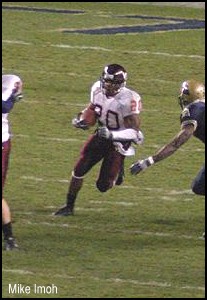 Opponent
punt returns have trended up strongly in the last few years, though, rocketing from the 4-5 yard range to 7.5, to 11.3
(ouch!) in 2002 and 10.0 in 2003.
Opponent
punt returns have trended up strongly in the last few years, though, rocketing from the 4-5 yard range to 7.5, to 11.3
(ouch!) in 2002 and 10.0 in 2003.
In Beamer's first 12 years at VT (1987-1998), opponents returned just one punt for a touchdown against Tech, in the 1988 season (by Southern Miss). Since then, it has happened three times: Peter Warrick's return in the 1999 championship game, Riddle's punt return in the 2001 Syracuse game, and Burke's punt return in the 2002 Boston College game.
To me, it has seemed as if VT has been struggling in the area of kickoff coverage lately, but you can see that statistic has held pretty steady at no more than 21 yards per return in recent years. In reality, it's punt returns that have increased for the opposition in the last few years.
That makes me want to take a look at VT's punters.
Punting
I'm going to compare the four Jimmy Kibble years (1996-1999) to the four Robert Peaslee/Vinnie Burns years just completed. Here are the numbers.
|
VT Punting Statistics, 1996-2003 |
|||||||
|
Season |
Primary Punter |
Punts |
Ave. |
TB |
FC |
Inside 20 |
Blkd |
|
1996 |
Jimmy Kibble |
32 |
37.3 |
N/A |
N/A |
N/A |
2 |
|
1997 |
Jimmy Kibble |
50 |
45.1 |
6 |
2 |
19 |
4 |
|
1998 |
Jimmy Kibble |
52 |
41.5 |
2 |
13 |
21 |
1 |
|
1999 |
Jimmy Kibble |
46 |
38.4 |
4 |
13 |
16 |
0 |
|
2000 |
Robert Peaslee |
44 |
35.3 |
3 |
6 |
14 |
1 |
|
2001 |
Vinnie Burns |
59 |
37.8 |
6 |
9 |
20 |
1 |
|
2002 |
Vinnie Burns |
64 |
40.5 |
8 |
7 |
22 |
2 |
|
2003 |
Vinnie Burns |
57 |
39.8 |
7 |
7 |
15 |
0 |
|
TB = touchbacks; FC = fair catches; Blkd = punts blocked (attributed to team, and not individual) |
|||||||
What stands out to me about those statistics? Several things:
The Fair Catches. In his heyday of 1998 and 1999, 26 of Jimmy Kibble's 98 punts, or 26.5%, were fair caught -- in other words, not returned.
Not coincidentally, VT opponents averaged just 4.1 yards per return during those two seasons. Those two statistics tell you that Kibble (as inconsistent as he was at times) was getting good hang time on his punts, and opponents were either fair catching them or were not able to return them, because the coverage team was arriving at the same time as the punt.
Kibble wasn't perfect, though -- he line-drived that punt to Peter Warrick in the Sugar Bowl, one-hopping it and giving Warrick a chance to survey the field before he took off like a rocket for his TD. As a senior in his last game, Kibble should have done better. But I digress.
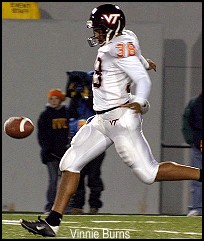 Since
Kibble left, Robert Peaslee and Vinnie Burns have had just 29 of 224 punts fair caught, or 12.9%, roughly half of
Kibble's average. During that time, opponents have averaged 5.5 to 11.3 yards per return, much higher than the 4.1
posted during Kibble's two best years. Translation? Peaslee and Burns didn't keep the ball in the air as long as Kibble,
resulting in fewer fair catches, and opponents were able to return it better, because the coverage team wasn't arriving
with the ball.
Since
Kibble left, Robert Peaslee and Vinnie Burns have had just 29 of 224 punts fair caught, or 12.9%, roughly half of
Kibble's average. During that time, opponents have averaged 5.5 to 11.3 yards per return, much higher than the 4.1
posted during Kibble's two best years. Translation? Peaslee and Burns didn't keep the ball in the air as long as Kibble,
resulting in fewer fair catches, and opponents were able to return it better, because the coverage team wasn't arriving
with the ball.
The Touchbacks-to-Coffin Corner (Inside the 20) Ratio. Ideally, that ratio should be low (few touchbacks versus kicks inside the 20), indicating that your kicker is doing a good job of landing the ball inside the 20, instead of kicking it into the end zone.
Kibble's 1998-99 ratio of touchbacks to coffin corner kicks was 6 to 37, or roughly 1 touchback for every 6 coffin corner kicks. Kibble generally did a good job of getting the ball inside the 20 without kicking it into the end zone.
For Peaslee and Burns, that ratio is 24 to 71, or almost exactly 1 to 3, much worse than Kibble's ratio. Peaslee and Burns were much more likely to kick the ball into the end zone for a touchback then Kibble was.
Punting Average. Kibble averaged 41.0 yards per punt in his career, and in the last four years, Burns and Peaslee have averaged 38.6 yards per punt. The ball isn't going as far with them as it did with Kibble.
The bottom line? Punting performance has slipped since Kibble left. The ball doesn't go as far, more of them are being returned (fewer fair catches), and the ability to drop the ball inside the 20, versus kicking it into the end zone, is only half as good as it was with Kibble.
Lastly, the last piece of the puzzle, and one that has been problematic for about three years now: placekicking.
Placekicking
Shayne Graham's records speak for themselves. He is the all-time VT scoring leader with 371 points. Touchdown machine Lee Suggs is second with 336 points, and Carter Warley is third, with 307 points.
But no one will compare Carter Warley favorably with Shayne Graham.
At this point, I could start to talk about the two kickers subjectively, saying that Graham made this pressure kick (WVU, 1999) and missed that one (Miami 1998, end of regulation), and Warley made this pressure kick (Pitt 2000) and missed � well, take your pick (but I won't).
I'd rather just look at the raw numbers and interpret them.
|
Virginia Tech Field Goal Statistics, 1996-2003 |
|||||
|
Season |
Kicker |
Overall FGs |
Under 40 Yds |
40+ Yds |
Long |
|
1996 |
Shayne Graham |
10-16 |
10-15 |
0-1 |
35 |
|
1997 |
Shayne Graham |
19-23 |
15-15 |
4-8 |
48 |
|
1998 |
Shayne Graham |
22-32 |
14-19 |
8-13 |
53 |
|
1999 |
Shayne Graham |
17-22 |
9-10 |
8-12 |
52 |
|
2000 |
Carter Warley |
7-9 |
5-6 |
2-3 |
47 |
|
2001 |
Carter Warley |
11-21 |
11-17 |
0-4 |
39 |
|
2002 |
Carter Warley |
9-15 |
6-9 |
3-6 |
43 |
|
2003 |
Carter Warley |
12-18 |
11-14 |
1-4 |
43 |
|
Shayne Graham's Totals |
68-93 (73.1%) |
48-59 (81.3%) |
20-34 (58.8%) |
53 |
|
|
Carter Warley's Totals |
39-63 (61.9%) |
33-46 (71.7%) |
6-17 (35.3%) |
47 |
|
One point from the data is obvious: Graham's overall percentage was better, and from 40 yards out, it's no contest: he was a much more accurate kicker than Warley. I'm not here to say why, mind you -- everyone knows Warley has a bad back, and it's hard to say how much that affected him -- I'm here to just point out the facts, namely that the field goal kicking was much less productive in the last four years than it was under Graham, particularly from 1997-1999.
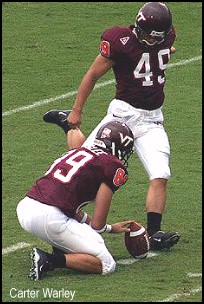 One point
from the data is a bit more subtle: due to Warley's inability to hit field goals beyond 40 yards, he tried only half as
many in four years than Graham did. How many times did Frank Beamer pass on the long field goal attempt and either (a)
go for it on fourth down, or (b) punt?
One point
from the data is a bit more subtle: due to Warley's inability to hit field goals beyond 40 yards, he tried only half as
many in four years than Graham did. How many times did Frank Beamer pass on the long field goal attempt and either (a)
go for it on fourth down, or (b) punt?
Perhaps the reason Vinnie Burns has a higher touchback-to-coffin corner ratio than Jimmy Kibble did is because he has been forced to punt more from closer to the opponent's goal line, because Beamer wasn't confident that Warley could hit a field goal. This stuff is all tied together.
Beyond the statistics, there are the games Warley couldn't win for Tech, because he missed field goals, primarily the 2002 Syracuse game and the Insight Bowl game.
Shayne Graham was a great kicker, and he's kicking in the NFL now (22-25 on field goals for the Bengals this year). The dropoff from him to Warley was significant, not just in production but in how Frank Beamer strategized the game, and the confidence -- or lack thereof -- he had in his kicker.
We have also seen an increase in the number of kickoffs that have not gone into the end zone for touchbacks � I think. Unfortunately, VT's media guides do not list the number of touchbacks versus non-touchbacks, so I can't back that up with statistical analysis. But it does seem as if VT's kickoffs have been shorter and lower, giving the opponents more chances to return them.
Conclusions
If you've been able to hang in there through that statistical analysis, then you've seen that I've drawn the following conclusions:
- VT is still a great kick-blocking unit and in the last four years has added the punt return for a touchdown to its arsenal of weapons.
- Punt coverage has started to suffer in the last few years, with opponents' punt return averages increasing sharply and punt returns for TDs becoming more common.
- VT's punting has suffered from a drop in punting average and fair catches, with an increase in touchbacks versus punts inside the 20. The drop in average and fair catches has led to increased punt return averages by the opponents.
- Field goal kicking has become shaky, especially outside of 40 yards. This has led to games being lost due to missed field goals and strategy being altered to VT's detriment. It has even negatively affected punting, because more punts are being called closer to the opponent's goal line.
How will VT improve upon these things? Well, hold on to your chair, because my answer is phenomenally simple: get better punters and placekickers. Yeah, I know, that's a stunning revelation.
Who are those kickers and punters going to be? Who knows? Shayne Graham was a rarity at VT: a kicker on scholarship. Almost every other kicker under Beamer, at least recently, has been a walk-on. The exception is Nic Schmitt, who was given a scholie by VT after a great high school career in Salem. But Schmitt has not taken to the placekicker's role as Graham did, going 2-for-6 in limited duty in 2002, including going 0-for-4 from 30 yards and beyond.
Schmitt was redshirted in 2003, and according to the latest Hokie Huddler (January 16, 2004) worked mostly at punter in the latter stages of the season. Schmitt is still listed as one of the placekickers on the BeamerBall.com depth chart, so long-term, he could wind up anywhere as the Hokies search for a replacement for Warley.
Speaking of the current depth chart, redshirt freshman Brandon Pace and freshman Jeff Scudder are now listed 1-2 on the depth chart, with redshirt freshman Schmitt, freshman Jud Dunleavy, and freshman John Hedge all grouped in a pack behind them.
The Hokies have not offered any scholarships to kickers this year and won't. One current high school kicker of interest is Radford's Trey Mitchell, a strong-legged marksman who broke Graham's VHSL record of 17 field goals in a season, going 20-of-24 as a senior. Mitchell, who ended his high school career 37-of-44, finished one behind Graham's career record of 38. One source says that Mitchell has been asked to walk on at VT, but it's not clear if he will.
At punter, Vinnie Burns has one more year, with Schmitt being the only other player listed at the position.
With DeAngelo Hall gone early to the NFL and no one of his ability ready to step into the punt returner position, my guess is that you'll see the Hokies return to more of a kick block mentality, as opposed to setting up the return.
But for the most part, all that's really needed on special teams is for the placekickers and punters to be better. Job one is to get a kicker who can not only win games, but who won't lose them by missing field goals, especially short ones. And of course, get a kickoff artist who can put the ball in the end zone.
Whether it's the coaching or the talent, the Hokies have not had a kicking duo in the last four years like they did
with Kibble and Graham from 1996-1999, and it has led to a decline in overall special teams performance. The Hokies are
still very good on special teams, and they may be back to their old standards in the future.